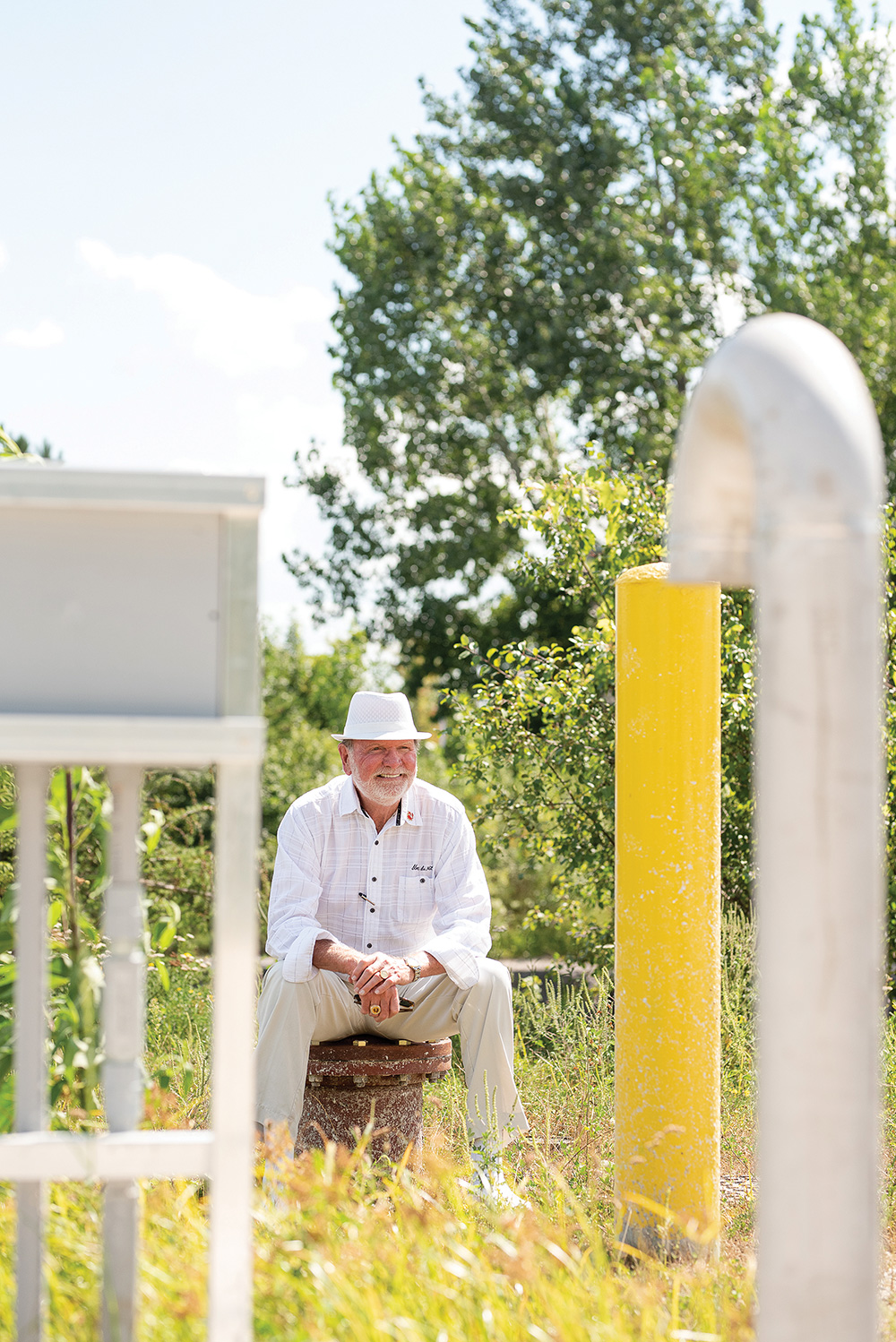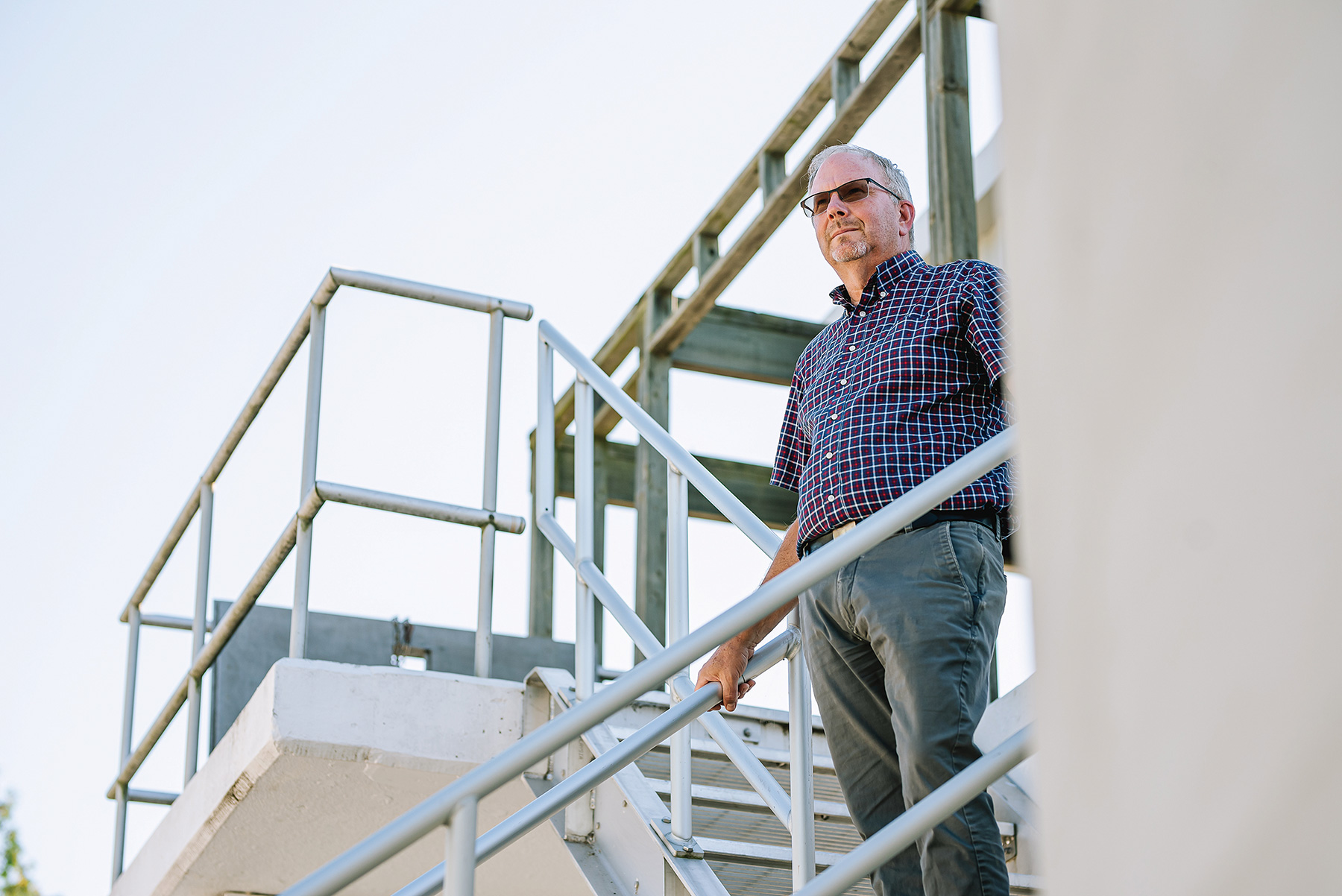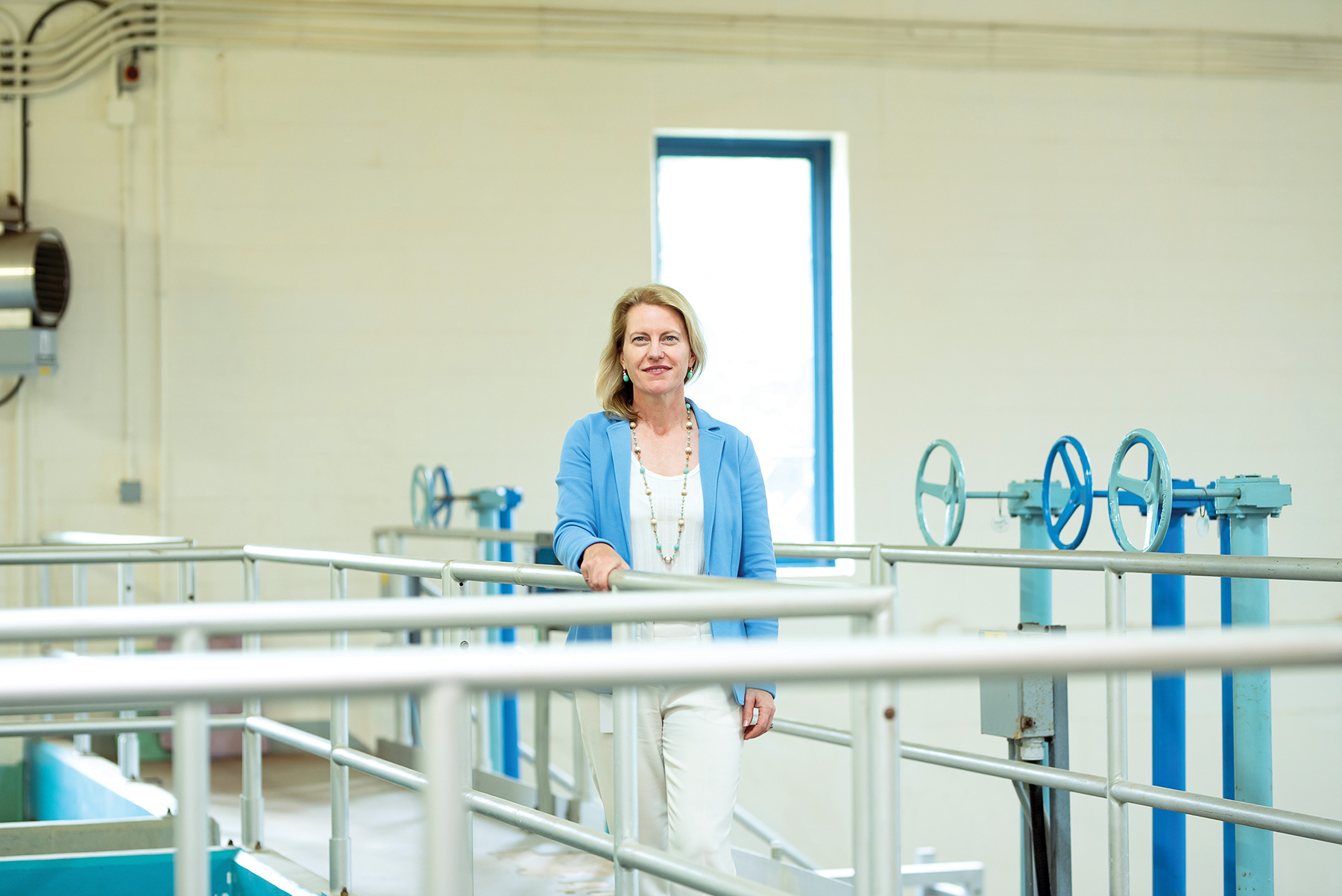Why was Collingwood forced to turn off the tap on new development? Why isn’t water treatment keeping pace with growth? How do we ensure we’re not growing too fast for infrastructure to keep up?
story by Marc Huminilowycz
photography by Jessica Crandlemire
On April 26, 2021, Collingwood Town Council shocked local residents, developers and bordering municipalities alike when it passed an Interim Control Bylaw (ICBL), which essentially turned off the tap on new developments for at least one year due to a projected shortfall in its treated water capacity.
The announcement outraged local developers in the midst of various stages of project approvals. It also caused consternation among Collingwood residents and bordering municipalities, which have treated water supply agreements with the Town of Collingwood.
Over the years, On The Bay has been reporting on growth and new residential development in each Spring issue, interviewing developers and planners from the five municipalities in Southern Georgian Bay. We compared their statistics on new residential development from year to year and examined projections for our municipalities in their Official Plans and the province’s Growth Plan for the Greater Golden Horseshoe, which is administered by the Ministry of Infrastructure.
It has been evident over the past three years that all municipalities in our region have seen a growing demand for new housing – especially during the past year, which saw a combination of unstoppable market demand and new interest from outside of our region due to changes in living patterns associated with COVID-19. Along with this came concerns about supply, affordability, and sustainability.
In our Spring 2020 issue, On The Bay began its analysis of the development picture as follows: “As developers eagerly cash in on the growing demand for housing in Southern Georgian Bay – offering a mix of residential types to their new home palette – municipal planners scramble to keep up with development proposals, approvals and site services. Meanwhile, some local citizens are concerned about the sustainability of what they view as rampant building activity, fearing it will impact municipal infrastructures, local traffic, the environment and the character of the communities they love.”
With all the evidence of the continued growth in our region, including the projections of municipal Official Plans and the provincial Growth Plan, we have to ask, “What happened?” Is Collingwood’s water treatment crisis the “canary in the coal mine”? Should other local municipalities be concerned about their infrastructure?
On April 26, 2021, Collingwood Town Council shocked local residents, developers and bordering municipalities alike when it passed an Interim Control Bylaw (ICBL), which essentially turned off the tap on new developments for at least one year due to a projected shortfall in its treated water capacity.
The announcement outraged local developers in the midst of various stages of project approvals. It also caused consternation among Collingwood residents and bordering municipalities, which have treated water supply agreements with the Town of Collingwood.
Over the years, On The Bay has been reporting on growth and new residential development in each Spring issue, interviewing developers and planners from the five municipalities in Southern Georgian Bay. We compared their statistics on new residential development from year to year and examined projections for our municipalities in their Official Plans and the province’s Growth Plan for the Greater Golden Horseshoe, which is administered by the Ministry of Infrastructure.
It has been evident over the past three years that all municipalities in our region have seen a growing demand for new housing – especially during the past year, which saw a combination of unstoppable market demand and new interest from outside of our region due to changes in living patterns associated with COVID-19. Along with this came concerns about supply, affordability, and sustainability.
In our Spring 2020 issue, On The Bay began its analysis of the development picture as follows: “As developers eagerly cash in on the growing demand for housing in Southern Georgian Bay – offering a mix of residential types to their new home palette – municipal planners scramble to keep up with development proposals, approvals and site services. Meanwhile, some local citizens are concerned about the sustainability of what they view as rampant building activity, fearing it will impact municipal infrastructures, local traffic, the environment and the character of the communities they love.”
With all the evidence of the continued growth in our region, including the projections of municipal Official Plans and the provincial Growth Plan, we have to ask, “What happened?” Is Collingwood’s water treatment crisis the “canary in the coal mine”? Should other local municipalities be concerned about their infrastructure?
Thomas Vincent, developer of Collingwood’s highly successful Balmoral Place Retirement Community, is livid about Collingwood’s sudden imposition of the ICBL, calling it “draconian” and “unfair” (although two blocks of Balmoral are exempt from the ICBL).
“I have spent the past 15 years of my time and money on this project,” he says, estimating that, once complete, the development will generate $2 million in taxes annually for the town. “How did this happen? For one thing, you have to be careful with population projections. Collingwood’s population says 22,500, but this doesn’t count 4,000 to 5,000 residents who have vacation/weekend homes here. Governments set population targets that have nothing to do with reality and markets. They’re unrealistic. Actual figures are always higher.”
In Vincent’s opinion, Collingwood did several things wrong in dealing with its treated water issue. “Around 2015/2016, there was an initiative to replace the water treatment plant. It was shelved. Show me the report. Why was this not acted upon?” demands Vincent, adding that the town had also collaborated at one point with engineering firm consultants working ‘pro bono’ to come up with solutions, which were ignored.
“Every year, each municipality in Ontario, including Collingwood, has to submit a report to the Ministry of the Environment on the status of its water treatment facilities – present and future. Does this not show a trend analysis? I have asked the town several times for access to these reports, but have been directed to their website, where I couldn’t find them.” (On The Bay was able to access these reports from the town. The data appears to show annual treated water volume close to or below the Collingwood’s average use of 6.6 million cubic metres from 2014 through 2017, with increases above this average from 2018 through 2020.)
Vincent says he has presented these and other concerns to Collingwood council and staff. His main bone of contention with the town is that it did not consult with local developers about its water problem. “I question any municipality that comes out with a red alert one day, then passes an ICBL four days later,” he says. “They must have been meeting for months on the issue, with no public or industry consultation.
I asked the town many times to collaborate with the development community, without success. Where was the planning? There was no collaboration with our industry, and no consultation. I am totally disappointed with our town. There’s no effective leadership on council or in the planning department. If they cannot show competence, then they’re incompetent.”
Rob Voigt, President of the Georgian Tringle Development Institute (GTDI), is a professional planner who, prior to his current position as Director of Planning at Parkbridge Lifestyle Communities, also worked in the public sector, including the Town of Collingwood.
Like developer Thomas Vincent, Voigt is very vocal in his criticism of Collingwood’s imposition of the ICBL on local developers, stating that, with population projections going back decades, the town should have done a better job of monitoring its infrastructure. “It’s no surprise that this happened, given the exponential growth combined with the length of time it takes – up to five years – to bring a project online in the development process. This is stuff the town has been negotiating for half a decade.”

“With more development than wastewater capacity right now, we’re monitoring the situation carefully. Because there is a four to five-year gap in construction, and we don’t allocate capacity with developers without signed agreements, some development may be delayed.”
Following the announcement of the ICBL, the GTDI immediately issued a letter to the Collingwood mayor and council, stating its strong disapproval of the decision citing, among other things, a “lack of transparency behind town staff’s formulation of this … town-wide development freeze.”
The letter pointed out that GTDI members “have been working with the town in the building of infrastructure, and the study and management of the water treatment plan for decades.” It stated that, although GTDI members have been continually involved in discussions with town staff throughout the development process, the town never indicated to them that “such an exaggerated reaction and heavy-handed measure was being contemplated.”
Responding to the town’s press release justifying the ICBL due to exponential growth in Collingwood over the past five years, placing greater demand on its water treatment plant, the GTDI letter stated, “the fact is, that development applications and scale of growth have long been prescribed in the province’s Places to Grow Act of 2005, and codified in the Official Plan, Zoning By-law and Draft Approval Plans for subdivisions.”
Voigt points out that GTDI members presented numerous submissions to council, offering solutions to the water issue. Key among these, dated following the town’s decision to offer exemptions to the ICBL, was a joint submission from two reputable professional engineers in Collingwood: Christopher Crozier, founder of Crozier & Associates Consulting Engineers, and Dan Hurley, President of Tatham Engineering.
The submission presented seven solutions to help the town manage its water capacity issue. These included adjustments, reviews and equipment add-ons regarding chlorine dosing in the winter to increase winter capacity, and short-term capacity reductions with The Blue Mountains and New Tecumseth (which currently have treated water supply agreements with Collingwood).
“The GTDI has always supported an engineering solution to engineering and land use. We’re concerned that the town’s solution to this problem is a land use approach,” says Rob Voigt. “We feel that a former Director of Planning Staff Report on the topic was convoluted. A town engineer offered several solutions, but planning felt that a policy solution was needed. As a planner myself, I believe that a policy document will not drive a solution to an infrastructure issue. It lies with the work of engineers. It’s a tap issue versus a size issue. Why is it not being done where it really belongs?”
Voigt is in strong agreement with Thomas Vincent about Collingwood’s hesitancy to involve local developers and engineers in the issue. “How can council ignore the voices of our industry?” he asks. “Every single road, facility, park and trail has been designed and built by us. Council celebrates and rewards other businesses and professions with grants, etc. But it has failed to consult with us. We raised warning flags about the water issue, but they made a hasty decision. We need to be at the table to help focus on engineering as the solution, in order to build a better community.”
It is apparent that the voices of Collingwood’s development community are loud and strong with respect to the town’s handling of the water issue. According to a letter to the editor published in Collingwood Today, it also appears that some citizens, prompted by the water treatment capacity shortfall, are concerned about the rapid growth of their town. The letter writer asks, “Do we want to continue to be one of the fastest-growing communities, ending up as just another characterless, sprawling mall-bound town?”
As to the treated water issue, one prominent Collingwood resident (who requested not to be named) has been keeping a watchful eye on Collingwood municipal politics, decisions and plans for many years. While this source believes that the town’s imposition of the ICBL was the right thing to do under the circumstances, they question how the treated water shortfall could have happened in the first place.
“Every municipality in our region has experienced a boatload of staff turnover. When control switches, things fall through the cracks. I frankly think someone messed up with all the staffing changes, but I don’t know for sure.” Referring to Collingwood’s “Vision 2020” strategic plan, created in 1999/2000, the interviewee notes that the town’s population projected at the time for 2021 was 30,357, with an additional 3,700 housing units to accommodate growth. “At our current population [approximately 25,000], we didn’t even meet that target, so the excuse of growth occurring too fast really doesn’t hold water.”
To answer these questions and concerns from the development community and concerned citizens about Collingwood’s treated water shortfall and resulting ICBL, On The Bay interviewed Collingwood Chief Administrative Officer (CAO) Sonya Skinner (a professional engineer, incidentally), who was hired in October of 2020.
When asked why the town only realized recently that its water treatment facility did not have sufficient capacity, and suddenly imposed an ICBL on developers in the midst of brisk building activity in the town, Skinner described the issue as “a perfect storm, in three parts.”
With regard to Collingwood’s “Vision 2020” Community-Based Strategic Plan, which projected a population of over 30,000 in 2021, Skinner says, “Two other strategic plans involving community input were created afterwards, with the latest plan approved last July. In addition, the town has, with the help of the community, undertaken several studies to ensure sustainable growth and quality of life, including Servicing, Parks, Recreation & Culture, Traffic and Transportation, Fire Protection, and Economic Development.”
The town’s Official Plan, dated January 2019, is currently in the process of being updated, with presentation to council scheduled in 2021. With regard to infrastructure and development, it states, “It is the intent … that no major forms of new development be permitted unless adequate municipal water, sanitary sewer and storm sewer facilities are available” and that “new development will be generally contiguous to existing built-up areas to avoid leap-frogging over undeveloped lands.”
“As a town with an overall budget of about $100 million, we work hard to make sure that the town’s vision is articulated, and that we further develop it through our Master Plans,” says Skinner. “Considering public input, council endorses the directions we are taking as a community, and staff work very hard to make sure that services and more are planned and delivered.”
Another factor in part one of the “perfect storm,” according to Skinner, was the occurrence of a couple of large industries moving out of Collingwood in 2013, which significantly reduced the town’s water needs. The third factor involved an error in a long-standing calculation related to water chlorination in Collingwood’s Water Treatment Plant in 2018. She explains:
“In cold water, chlorine is less effective, so more of it needs to be added to achieve virus removal to provincial standards. An error was discovered with one of the parameters used in the chlorine disinfection calculation. When corrected, the result was more chlorine must be added during cold water conditions to achieve sufficient disinfection. This limits the volume of water that can be produced during winter. With our winter limitations, the allocation of future demand now needed to consider a lower available capacity, and the way allocation is provided for potential development needed to be reconsidered.”
According to Skinner, mounting population growth before and during COVID-19, combined with already approved but de-activated plans being re-activated, created the second part of the perfect storm, with “more development in the pipeline than before.”
“With the maximization of our chlorine option, we have water for several years of development at the expected pace,” she says. “If our efforts to enhance our winter disinfection in the next couple of years are successful, and we can reduce some of the flow that we have held as a water safety factor, then a reasonable water supply for new development should be available through to the opening of the expanded water treatment plant.”
That said, Skinner explains that, since the additional water supply is not guaranteed, Collingwood staff have advised council that water should only be allocated to developments that are ready for building permits. “With the exemptions [to the ICBL] awarded by council in 2021, we anticipate being roughly consistent with the amount of construction that occurred in 2020,” she notes.

“We could have improved things on the staff side. We were not as connected as we could have been in communicating the increasing speed and volume of developments. We could have done a better job in managing the release of water allocation in relation to the timing of development, to help ensure we were projecting all the developments as accurately as practical.”
“We could have improved things on the staff side,” Skinner adds. “We were not as connected as we could have been in communicating the increasing speed and volume of developments. We could have done a better job in managing the release of water allocation in relation to the timing of development, to help ensure we were projecting all the developments as accurately as practical. Going forward, we are establishing a better coordination between our planning, public works and finance departments to ensure we are well connected.”
Skinner describes the third part of the perfect storm as “growing pains” regarding setting up a water allocation regime and involving developers in water discussions earlier. “The town was several years too late to do a collaborative approach,” she says. “Ideally, as any town grows, it will set up a regime for the allocation of services such as water and wastewater, preferably while there is ample servicing available, and where residents and businesses, including developers, can have thoughtful public conversations about allocation that will support their community’s growth.”
Skinner says in hindsight, collaboration with developers and engineers might have helped. “If we had sat down with them, there may have been voluntary options negotiated that would have enabled a collaborative solution to our water challenges,” says Skinner. “However, Collingwood was planning for a water treatment plant expansion, and had started the process with the completion of a Class Environmental Assessment. The town looks forward to collaborating with these professionals in working through the next steps for water allocation.”
She adds, “I fully understand that developers were surprised by the ICBL. I was surprised. It’s a blunt but fair instrument that makes sense at this time. Its purpose is to buy time to study options. The development paperwork can continue. This is not a barrier. We set up something as quickly as we could to allow developers to continue the business end.”
Skinner admits that a 2025 target completion date for the water treatment plant expansion is aggressive, and may take longer. “The town has hired a design consultant, and we’re asking: ‘What can we do?’ ” A report from the consultant, due in early fall of this year, could result in more than 800 new development units being approved, according to Skinner. “We’re looking for go-to solutions that will allow developers to have clear expectations on when they can access water. We want to keep the taps on for new development.”
What does Collingwood’s water issue mean for other municipalities in Southern Georgian Bay? Are their infrastructures and community services prepared for the inevitable growth in our region? The province’s Growth Plan for the Greater Golden Horseshoe, recently updated from a 2017 version, projects that, between 2021 and 2051, the County of Simcoe will expand its population from 357,000 to 555,000. This is being factored into Simcoe County’s Official Plan update.
The Growth Plan will be allocating a large portion of this projected growth to Primary Settlement Areas (PSAs), with some growth allocated to other area municipalities. Collingwood will continue to be the only PSA in Southern Georgian Bay. According to an Official Plan Update Discussion Paper dated July, 2020, Collingwood estimates that it will capture 10 per cent of Simcoe County’s total population growth by 2041, amounting to a population of 41,500 people.
The Town of Wasaga Beach hopes to be classified as a PSA in the updated Growth Plan and Simcoe Official Plan, and is currently updating its own Official Plan to accommodate for growth. The existing Growth Plan estimates that the population of Wasaga Beach will grow from the last census of 20,675 to 27,500 by 2031. The updated Plan forecasts 40,000 to 50,000 people by 2051. The Town already has in place growth and intensification policies for “Growth Nodes,” with existing treated water demand at only 54 per cent of its design capacity, and its wastewater plant operating at 43 per cent of capacity.
The Blue Mountains, which is not within the province’s Growth Plan, continues to be proactive in developing sustainable growth strategies with input from its citizens, with respect to infrastructure, transportation, parks, and quality of life. It even has a Fire Master Plan, according to CAO Shawn Everitt. “Our demographics are changing and, with the high cost of living here, volunteer firefighters are tough to retain.”
Collingwood’s treated water shortfall has directly impacted The Blue Mountains, with which it has a long-standing water purchase agreement. (As mentioned earlier, Collingwood is considering reducing the amount of water it sells to The Blue Mountains.) “The ICBL caught us all by surprise, and it’s alarming,” says Everitt. “We’ve looked at our capacity, as well as all options for the future, and I think we’re farther ahead than Collingwood, with established projects from east to west under way. The water issue is timely for us, forcing us to take steps to make sure we’re prepared.”
“We are continuing to work with Collingwood to maintain our water agreement as best as possible,” Everitt adds. “At the same time, we are determining our flexibility – what capacity we’re willing to give up and what we can live with – and starting to look at our own water infrastructure. The next three to five years are critical for us, with huge developments like Castle Glen coming up. We will be conducting east and west end water studies to identify needs, and a future expansion of our wastewater facility, which is getting close to capacity, is scheduled for completion by early 2024.”
Meaford Chief Administrative Officer Rob Armstrong says that municipality is set up for future growth with respect to treated water, having completed a major update to its plant in the early 2000s, and currently at only 15 per cent of its capacity. The bigger issue for Meaford is wastewater.
“With more development than wastewater capacity right now, we’re monitoring the situation carefully,” says Armstrong. “Because there is a four to five-year gap in construction, and we don’t allocate capacity with developers without signed agreements, some development may be delayed. Right now, we’re in the environmental assessment stage for a new wastewater facility. In the meantime, we’re doing everything we can to keep development going.”


“We are continuing to work with Collingwood to maintain our water agreement as best as possible. At the same time, we are determining our flexibility – what capacity we’re willing to give up and what we can live with – and starting to look at our own water infrastructure.”
Is the growth and sustainability situation in Collingwood and other Southern Georgian Bay municipalities unique in Ontario? Not at all, according to a May 2, 2021 article in the Toronto Star reporting on Collingwood’s water issue, which stated, “Collingwood now joins other Ontario communities that are waving red flags about the scale of development and problems associated with planning and management of water and infrastructure.”
A respected senior professional planner in Toronto, who asked not to be named, notes, “There’s no doubt that COVID-19 has been pushing people out of the cities into rural parts of Ontario, and there’s definitely growth pressure everywhere. Meanwhile, there’s nothing new being built in Toronto. Some [outlying] municipalities may or may not have their own planners and engineers. They need a CAO who understands this and hires the right people – like a long-range planner who determines how much land is available, and accurately predicts how many people are using water and flushing toilets, then rolls this over to engineering to determine what to build.
“Water and sewer plants are very expensive. You need to get provincial/federal funding, and studies done. And, despite funding and development charges, you may also have to charge your existing population to pay for new development.”
Of all the municipalities in Southern Georgian Bay, Clearview Township has experienced the most dramatic growth in terms of population and new residential development. In last spring’s issue of On The Bay, Clearview’s Director of Community Services, Mara Burton, was quoted as follows:
“We have around 4,000 units in draft plan and a couple of hundred registered or pending registration this year. We are working through some water capacity constraints with our developers in Stayner, and sewer capacity constraints in Creemore in an effort to keep permits flowing as much as possible.”
When asked recently about the current future state of the municipality’s infrastructure, and the infrastructure challenges of accommodating growth and new development, Burton replied with the following email:
“In regard to planning for servicing for developments in Clearview, we are always keeping on top of development in relation to our infrastructure. It is challenging for any municipality because the demand for sewer and water can change rapidly from year to year, but the building of the services takes multiple years. For instance, if you only have one developer wanting to construct, then you may have sewer and water capacity at that rate of growth for many years. However, if suddenly a number of developers want to bring their projects on line all at the same time, then the capacity can get taken up quite quickly.”
Before any shovel goes into the ground, a number of things have to happen, notes Burton, including the undertaking of Environmental Assessments, budgeting, going to tender and constructing the project. Existing distribution pipes under roads throughout a municipality may need to be upsized. Therefore, it can take several years before a municipality has the expanded capacity to meet that sudden and changing demand.
“Generally, municipalities do not want to overbuild their sewer and water plants for a couple of reasons,” writes Burton. “One is that they have to upfront some or all of the costs and recover it through development charges, which are generally paid once a building permit is issued. If the market changes and the developers decide not to build, then the municipality has to wait in order to be paid back that investment.
“The municipality also has to consider that some infrastructure (pumps, drives and electronics etc. inside plants) have a limited life and require maintenance and replacement. It does not want to have to replace overbuilt infrastructure before it is needed and paid for.”
Like the rest of the world, we in Southern Georgian Bay have experienced the tragic circumstances, personal upheaval and dramatic disruptions resulting from the global pandemic, with death, illness, lockdowns, social distancing and remote work.
Although our region has experienced steady growth over the years, COVID-19 brought a sudden influx of people from Ontario’s urban centres, looking for a better way of life. Our municipalities have evolved over time to be more transparent and, with input from members of their communities, more proactive in preparing themselves and their citizens for a future of sustainable growth. Mistakes have happened along the way. Maybe they should be considered “growing pains,” from which our municipal councils and staff can learn, improve, and work together with the community to ensure that development is managed, infrastructure is planned, and the taps never go dry. ❧


“We have around 4,000 units in draft plan and a couple of hundred registered or pending registration this year. We are working through some water capacity constraints with our developers in Stayner, and sewer capacity constraints in Creemore in an effort to keep permits flowing as much as possible.”


















